According to a report by the Election Commission of India (ECI), voter turnout in Sikkim this year was 79.77 percent, slightly lower than in the 2019 assembly elections. The Himalayan state has a total of 464,000 registered voters.
The main contenders in the race for 32 seats are the Sikkim Krantikari Morcha (SKM) and the Sikkim Democratic Front (SDF). Other major parties in the fray include the BJP and the Congress. Currently, the SKM, under the leadership of Chief Minister Prem Singh Tamang, governs the state. The SKM is seeking to retain power for a second consecutive term, while the SDF, which dominated state politics for 25 years until 2019, is looking to regain its former status.
A party needs at least 17 seats to secure a majority and form the government. In the 2019 elections, the SKM won exactly 17 seats and Prem Singh Tamang became the chief minister, while the incumbent SDF was left with just 15 seats. This is a stark difference from the 2014 elections, when the SDF won 22 seats and Pawan Kumar Chamling became the chief minister for a fifth consecutive term.
As the count progresses, attention will turn to whether the SKM will be able to maintain its current position or whether the SDF will stage a strong comeback.

